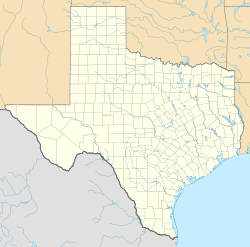Glen Flora, Texas facts for kids
Quick facts for kids
Glen Flora, Texas
|
|
|---|---|
| Country | United States |
| State | Texas |
| County | Wharton |
| Elevation | 118 ft (36 m) |
| Time zone | UTC-6 (Central (CST)) |
| • Summer (DST) | UTC-5 (CDT) |
| ZIP code |
77443
|
| Area code(s) | 979 |
Glen Flora is a small community in Wharton County, Texas, United States. It's called an "unincorporated community" because it doesn't have its own local government like a city does. In the year 2000, about 210 people lived there. Glen Flora is part of the larger Greater Houston area.
Contents
History of Glen Flora
Some of the first settlers in the Glen Flora area were John C. Clark and Robert Kuykendall. They were part of Stephen F. Austin's "Old Three Hundred" group, who were early American colonists in Texas.
Early Settlements and Industry
Around 1890, C. H. Waterhouse moved to Wharton County. He bought a lot of land along the Colorado River. He invited German families from his home state of Pennsylvania to work as tenant farmers on his land. Tenant farmers rent land to grow crops.
Waterhouse built a cotton gin and a large sugar mill across the river from his house. A cotton gin separates cotton fibers from their seeds. The sugar mill's pumping system was said to be the biggest in Texas! This company changed names a few times, including Pittsburg-Glen Flora Sugar Company.
Vesperville and the Church
The German families settled almost a mile west of the sugar plant. Waterhouse set aside five acres for a church and a cemetery. The locals called this community Vesperville.
They built St. John's Lutheran Church in 1895. Services there were only held in the German at first. The church building was destroyed three times: by a hurricane in 1909, a tornado in 1910, and a fire in 1918.
In 1919, the church moved to Glen Flora. But a tornado destroyed the new building in 1929. In 1941, the church decided to move to Wharton and change its name to St. Paul's Lutheran.
Founding of Glen Flora Town
The town of Glen Flora was officially started in 1898. This happened after the Cane Belt Railroad was built. The town was on the east side of the Colorado River, right across from the Waterhouse factory.
William Thomas Eldridge and William Dunovant were important investors in the railroad. A street in Glen Flora is named after one of them. Sadly, Eldridge shot Dunovant in 1902 while they were on a train.
The local post office opened in August 1900. In May 1902, the Glen Flora Town Corporation was formed, with Waterhouse as its first president.
Growth and Decline
William Hood suggested the name Glen Flora. It was also the name of his plantation. Hood owned a store with R. M. Martin. He later built a large brick building in the town.
Glen Flora grew quickly. It had many businesses, like stores, two cotton gins, a meat market, a drugstore, a hotel, a bank, a gristmill (which grinds grain), a lumberyard, a movie theater, and a telephone company.
The sugar mill was allowed to build a rail line across the bridge over the Colorado River. This line helped transport sugar cane and cotton to the Cane Belt Railroad. Mules would pull the carts.
Glen Flora is surrounded by rich farmlands. After sugarcane became less popular, rice, corn, and cotton became important crops. For a while, potatoes were grown and shipped out. In the early 1980s, a large fruit orchard was started.
After 1960, Glen Flora's population began to shrink. People started moving to Wharton, and businesses in Glen Flora closed down. The Atchison, Topeka and Santa Fe Railway, also known as the "Cane Belt," stopped service in 1992. The railroad tracks were removed. From 1980 to 2000, the population stayed at 210 people.
Tornadoes in Glen Flora
Glen Flora has experienced tornadoes. On November 21, 1992, an F1 tornado damaged several barns northeast of the community. Another tornado on November 23, 2004, damaged four homes.
Glen Flora has a post office with the ZIP code 77443.
Geography of Glen Flora
Glen Flora is located where two roads, FM 102 and FM 960, meet. It is about 6 miles (10 km) northwest of Wharton. It is also about 17 miles (27 km) south of Eagle Lake and 5 miles (8 km) south of the community of Egypt.
Education in Glen Flora
The Glen Flora School District was created sometime after 1900. In 1905, it had 37 students and one teacher. There were also two separate schools for Black children in the community.
The school for White students joined the Crescent school district in 1948. Later, it became part of the larger El Campo Independent School District. The two schools for Black students combined into one, named after their principal, Thomas Lane Pink.
Starting in 1961, all students went to either El Campo or Wharton Independent School District. This happened after schools were desegregated, meaning students of all races could attend the same schools.
Notable People
- Harry H. Johnson: A soldier in World War II who was born in Glen Flora.
- Iris Kyle: A professional female bodybuilder.
Gallery






